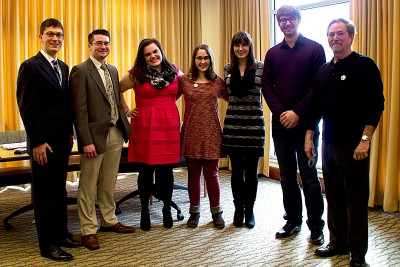 Neag School music education majors recently had the opportunity to chat and network with experienced music teachers at the mini-conference “Behind the Scenes of a Successful Program: a Professional Development Day for Aspiring Music Educators.”
Neag School music education majors recently had the opportunity to chat and network with experienced music teachers at the mini-conference “Behind the Scenes of a Successful Program: a Professional Development Day for Aspiring Music Educators.”
Organized by the UConn chapter of the National Association for Music Education (NAfME), the annual event attracted approximately 30 UConn students to the program, which included the following talks:
- “Tomorrow is Here: Technology Tools for Today’s Music Educator” by Wayne Pierce, Ph.D., director of music technology at Kingswood-Oxford School
- “Landing Job: Good, Keeping Job: Better” by Aaron Burgess, director of bands at Edwin O. Smith High School
- “Making the Program Your Own” by Ned Smith, director of instrumental music at Coventry High School
Music education junior and UConn NAfME chapter president Valerie Stickles was among those eager to take advantage of these professionals’ insights. “We hoped all the members of the chapter would benefit from different perspectives and experience, regardless of whether they were an instrumentalist or a vocalist,” Stickles said.
Joseph Abramo, assistant clinical professor of Music Education and advisor of the UConn NAfME chapter, was particularly interested to hear Pierce’s talk, as more students use computers, apps and other new technologies to make music. “One of my strains of research is finding the ways students engage with music outside of school,” Abramo said. “How to incorporate these ideas into the classroom highly resonated with current trends.”
Hoping to teach music in elementary or high school, Neag junior Allison Savage found the advice on how to land a job very helpful. “I had no idea so much goes into the interview process,” said Savage, who’s majoring in vocal performance and music education. “For example, a cover letter or even your outfit can make or break your chance at getting the job.”
Sean Sonntag, a freshman in pre-music education, said being able to hear from multiple educators in the field “allowed me to gain an understanding of different approaches to teaching, and gave me fresh ideas from people who have used and refined them.”
During his presentation, Smith said there is nothing more rewarding than encouraging students to think about the underlying reasons for teaching music. “I fear there are too many teachers who don’t have the time or support to stop and question why we are doing what we are doing,” Smith said. “We have stood on the shoulders of giants in defending music education. Just a short 25 years ago, music was not even a guarantee in public education. We must take what the generations before us did and continue having a dialogue with young people if we are going to promote music education as a viable course of study—not because of the extraneous benefits it might add to the educational environment, but because music is something worthy of studying purely because it is music.”
Abramo added: “Pre-service and practicing educators need to have exposure to a variety of ideas. In collaboration with other educators, we are able to learn best practices and new ways of conceiving what the goals and aims of music education can and should be, and find new and interesting projects to explore.”
 Facebook
Facebook
 Twitter
Twitter
 LinkedIn
LinkedIn
